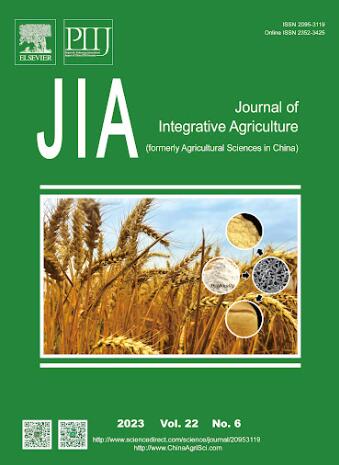Fhb9 是提高小麦镰刀菌头孢疫病抗性的主要 QTL
IF 4.4
1区 农林科学
Q1 AGRICULTURE, MULTIDISCIPLINARY
引用次数: 0
摘要
小麦头枯病(FHB)是全球最具破坏性的小麦病害之一,主要由小麦头枯病(FHB)引起。在不对农艺性状产生负面影响的情况下,鉴定和验证抗 FHB 的主要数量性状位点(QTLs)是成功培育抗 FHB 栽培品种的关键。在本研究中,通过在田间和温室试验中评估由施4185×施家庄8号衍生的重组近交系(RIL)群体,确定了染色体臂2DL上的一个稳定的主要QTL。QTL 图谱和血统分析表明,2DL QTL 与之前在 Ji5265 中鉴定出的 QTL 相同,因此将其命名为 2DL QTL。基于外显子组捕获测序数据开发了四个竞争性扩增片段序列多态性(KASP)标记,以提高该区域的标记密度,并将其限定在单核苷酸多态性(SNP)标记(533.8)和(525.9 Mb)之间的区间,解释了26.0-30.1%的表型变异。抗性等位基因的地理分布分析表明,该等位基因起源于中国黄淮冬麦区,而且在中国现代栽培品种中出现的频率很低,这表明该等位基因尚未广泛应用于育种计划中。对等位基因对比的近等基因系(NILs)产量相关性状的田间和温室评价表明,抗性等位基因对这些性状没有任何不利影响。因此,该等位基因是提高小麦 FHB 抗性的重要 QTL,本研究开发的近诊断标记将有助于在小麦育种计划中应用。本文章由计算机程序翻译,如有差异,请以英文原文为准。
Fhb9, a major QTL for Fusarium head blight resistance improvement in wheat
head blight (FHB), mainly caused by , is one of the most devastating diseases of wheat worldwide. Identification and validation of major quantitative trait loci (QTLs) for FHB resistance without negative effects on agronomic traits is critical to success in breeding FHB-resistant cultivars. In this study, a stable major QTL on chromosome arm 2DL was identified by evaluating a recombinant inbred line (RIL) population derived from Shi4185×Shijiazhuang 8 in both field and greenhouse experiments. QTL mapping and pedigree analyses indicated that the 2DL QTL is the same QTL as previously identified in Ji5265, therefore, designated . Four kompetitive amplicon sequence polymorphism (KASP) markers were developed based on exome capture sequencing data to enhance marker density in the region, and it was delimited to an interval between single nucleotide polymorphism (SNP) markers (533.8) and (525.9 Mb) explained 26.0-30.1% of the phenotypic variation. Analysis of the geographic distribution of the resistance allele suggested that it originated from Huang-Huai winter wheat region in China, and very low frequency of in modern Chinese cultivars reveals that it has not been widely deployed in breeding programs. Field and greenhouse evaluation of yield-related traits of near-isogenic lines (NILs) contrasting in alleles indicated that resistance allele did not show any adverse effects on those traits. showed an additive effect on enhancing FHB resistance with . Therefore, is a valuable major QTL for improving FHB resistance in wheat and the near-diagnostic markers developed in this study will facilitate its deployment in wheat breeding programs.
求助全文
通过发布文献求助,成功后即可免费获取论文全文。
去求助
来源期刊

Journal of Integrative Agriculture
AGRICULTURE, MULTIDISCIPLINARY-
CiteScore
7.90
自引率
4.20%
发文量
4817
审稿时长
3-6 weeks
期刊介绍:
Journal of Integrative Agriculture publishes manuscripts in the categories of Commentary, Review, Research Article, Letter and Short Communication, focusing on the core subjects: Crop Genetics & Breeding, Germplasm Resources, Physiology, Biochemistry, Cultivation, Tillage, Plant Protection, Animal Science, Veterinary Science, Soil and Fertilization, Irrigation, Plant Nutrition, Agro-Environment & Ecology, Bio-material and Bio-energy, Food Science, Agricultural Economics and Management, Agricultural Information Science.
 求助内容:
求助内容: 应助结果提醒方式:
应助结果提醒方式:


